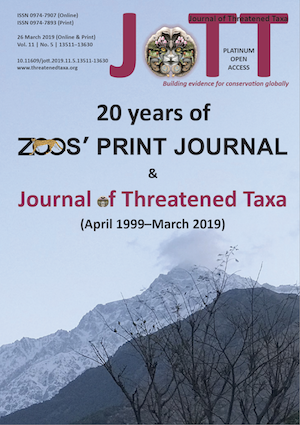Weed diversity in rice crop fields of Fatehgarh Sahib District, Punjab, India
Main Article Content
Abstract
A total of 31 species of weeds belonging to 11 families was collected from rice fields in Fatehgarh District of Punjab between June and November 2017. Of the 31 species, 15 were dicots and 16 were monocots. Of the 11 families, six (Portulacaceae, Lythraceae, Solanaceae, Scrophulariaceae, Polygonaceae, and Commelinaceae) were represented by only one species each. Poaceae was the largest family represented by 10 species, followed by Asteraceae and Cyperaceae with five species each. The largest genus was Cyperus with four species, followed by Euphorbia, Echinochloa, and Eragrostis with two species each. Of the 31 weed species, 29 were annual and only two, Cyperus rotundus and Parthenium hysterophorus, were perennials. More detailed survey work is required on a regular basis to identify possible problematic weeds and new or improved control measures.
Article Details
Authors own the copyright to the articles published in JoTT. This is indicated explicitly in each publication. The authors grant permission to the publisher Wildlife Information Liaison Development (WILD) Society to publish the article in the Journal of Threatened Taxa. The authors recognize WILD as the original publisher, and to sell hard copies of the Journal and article to any buyer. JoTT is registered under the Creative Commons Attribution 4.0 International License (CC BY), which allows authors to retain copyright ownership. Under this license the authors allow anyone to download, cite, use the data, modify, reprint, copy and distribute provided the authors and source of publication are credited through appropriate citations (e.g., Son et al. (2016). Bats (Mammalia: Chiroptera) of the southeastern Truong Son Mountains, Quang Ngai Province, Vietnam. Journal of Threatened Taxa 8(7): 8953–8969. https://doi.org/10.11609/jott.2785.8.7.8953-8969). Users of the data do not require specific permission from the authors or the publisher.
References
Bentham, G. & J.D. Hooker (1882–1883). Genera Plantarum, 3 vols. L Reeve & Co. London.
Chopra, R.N., S.L. Nayar & I.C. Chopra (1956). Glossary of Indian Medicinal Plants. CSIR, New Delhi, 256pp.
Evans, H.C. (1997). Parthenium hysterophorous: a review of its weed status and the possibilities for biological control. Biocontrol/News and Information 18(3): 89–98.
Hassan, G. & K.B. Marwat (2001). Integrated weed management in agricultural crops, pp27–34. In: Proceedings of the National Workshop Technologies for Sustainable Agriculture, 24–26 September. NIAB, Faisalabad.
Holm, L.G., D.L. Plucknett, J.V. Pancho & J.P. Herberger (1977). The World’s Worst Weeds: Distribution and Biology. University Press of Hawai, Hawai, 609pp.
Hooper, D.U., F.S. Chapin III, J.J. Ewel, A. Hector, P. Inchausti, S. Lavorel, J.H. Lawton, D.M. Lodge, M. Loreau, S. Naeem, B. Schmid, H. Setälä, A.J. Symstad, J. Vandermeer & D.A. Wardle (2005). Effects of biodiversity on ecosystem functioning: a consensus of current knowledge. Ecological Monograph 75(1): 3–35.
Ibrar, M.S., A. Hashim & K.B. Marwat (2003). Ethnobotanic study of the weeds of five crops in district Abbottabad, N-W. Pakistan Journal of Weed Science Research 9(3&4): 229–240.
Jain, S.K. & R.R. Rao (1977). A Handbook of Field and Herbarium Methods. Today and Tomorrow Printers & Publishers, New Delhi, India, 157pp.
Kaur, K., M.C. Sidhu & A.S. Ahluwalia (2017). Angiospermic diversity in Doaba region of Punjab, India. Journal of Threatened Taxa 9(8): 10551–10564. https://doi.org/10.11609/jott.2748.9.8.10551-10564
Kendler, B.S., H.G. Koritz & A. Gibaldi (1992). Introducing students to ethnobotany. The American Biology Teacher 54(1): 46–50.
Malik, R.K. & V. Kumar (2014). Zero tillage and management of herbicide resistance in wheat, pp64–70. In: Souvenir. Directorate of Weed Research, Jabalpur, India.
Manandhar, S., B.B. Sreshtha & L.D. Hari (2007). Weeds of paddy field at Kirtipur, Kathmandu, Nepal. Science World 5(5): 100–106.
Memon, M.I.A. & N.M. Shahani (1986). Survey and domestication of wild medicinal plants distribution in Sindh Province of Pakistan, pp191–193. Annual Research Report, Department of Plant Breeding and Genetics, Sindh Agriculture University, Tandojam.
Ram, H.Y.M. & P. Gupta (1997). Plant life under extreme environments. Current Science 72(5): 306–315.
Naidu, V.S.G.R. (2012). Hand Book on Weed Identification. Directorate of Weed Science Research, Jabalpur, India, 354pp.
Oudhia, P. (2000). Parthenium hysterophorus: a new weed in upland rice fields of the Chhattisgarh plains (India). International Rice Research Notes, Vol.25 No.1 pp.34 ref.4.
Parker, C. & J.D. Fryer (1975). Weed control problems causing major reductions in world food supply. FAO Plant Protection Bulletin 23(3/4): 83–95.
Rabbani, N. & R. Bajwa (2001). Weeds distribution in rice fields of 5 districts of Punjab. Pakistan Journal of Botany, Special Issue 33: 541–549.
Sharma, M. (1990). Punjab Plants—Check List. Bishen Singh Mahendra Pal Singh Publications, Dehra Dun, India, 115pp.
Sidhu, M. & S.S. Bir (1993). Karyological studies on weeds on cultivable lands in Punjab, India. Tropical Plant Science Research 1: 1–13.
Kumar, S. & J.G. Varshney (2010). Parthenium infestation and its estimated cost management in India. Indian Journal of Weed Science 42(1&2): 73–77.
Vasic, V., B. Konstantinovic & S. Orlovic (2012). Weeds in forestry and possibilities of their control. In: Price, A.J. (ed.). Weed Control. IntechOpen. Available online at https://www.intechopen.com/books/weed-control/weeds-in-forestry-and-possibilities-of-their-control. Accessed on 22 February 2018.

